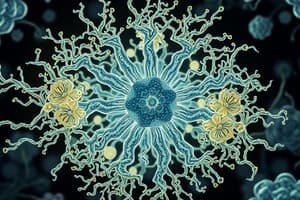Podcast
Questions and Answers
Where is Clostridium tetani typically found?
Where is Clostridium tetani typically found?
- Desert ecosystems
- Freshwater lakes
- Cultivated soil (correct)
- Mountainous regions
What type of environment does Clostridium tetani require to thrive?
What type of environment does Clostridium tetani require to thrive?
- Anaerobic environment (correct)
- Low-humidity environment
- Aerobic environment
- High-temperature environment
Through what means is Clostridium tetani typically introduced into the tissues?
Through what means is Clostridium tetani typically introduced into the tissues?
- -contaminated food
- Vector-borne transmission
- Airborne transmission
- Deep puncture wounds (correct)
In which animals does tetanus often follow docking or castration?
In which animals does tetanus often follow docking or castration?
Why may the point of entry of Clostridium tetani not be found?
Why may the point of entry of Clostridium tetani not be found?
What is a common initial presentation of black leg disease?
What is a common initial presentation of black leg disease?
What is a characteristic feature of black leg disease?
What is a characteristic feature of black leg disease?
Which of the following body parts can be affected in black leg disease?
Which of the following body parts can be affected in black leg disease?
What is the temperature of animals affected with black leg disease?
What is the temperature of animals affected with black leg disease?
What is the prognosis of animals found dead without premonitory signs of black leg disease?
What is the prognosis of animals found dead without premonitory signs of black leg disease?
Flashcards are hidden until you start studying
Study Notes
Etiology and Pathogenesis of Tetanus
- Causative agent: Clostridium tetani, an anaerobic bacterium with terminal, spherical spores
- Common sources: Found in soil, especially cultivated soil, and intestinal tracts
- Mode of transmission: Introduced into tissues through wounds, particularly deep puncture wounds, that provide a suitable anaerobic environment
- High-risk wounds: Deep puncture wounds, docking or castration wounds (especially in lambs and sometimes in other species)
- Occult infection: Point of entry may not be found due to minor or healed wounds
Black Leg Clinical Signs
- Few animals may be found dead without showing any previous signs of illness
- Acute and severe lameness, often affecting the hind legs, is a common clinical sign
- Marked depression is a prominent feature of the disease
- Fever may be present, but in some cases, body temperature can be normal or subnormal
Lesion Characteristics
- Characteristic edematous and crepitant swellings develop in various parts of the body
- Swellings typically occur in the hip, shoulder, chest, back, neck, or elsewhere
- Swellings are focal, hot, and painful
Rare Complications
- In extremely rare cases, the tongue can be affected, leading to protrusion
Studying That Suits You
Use AI to generate personalized quizzes and flashcards to suit your learning preferences.




